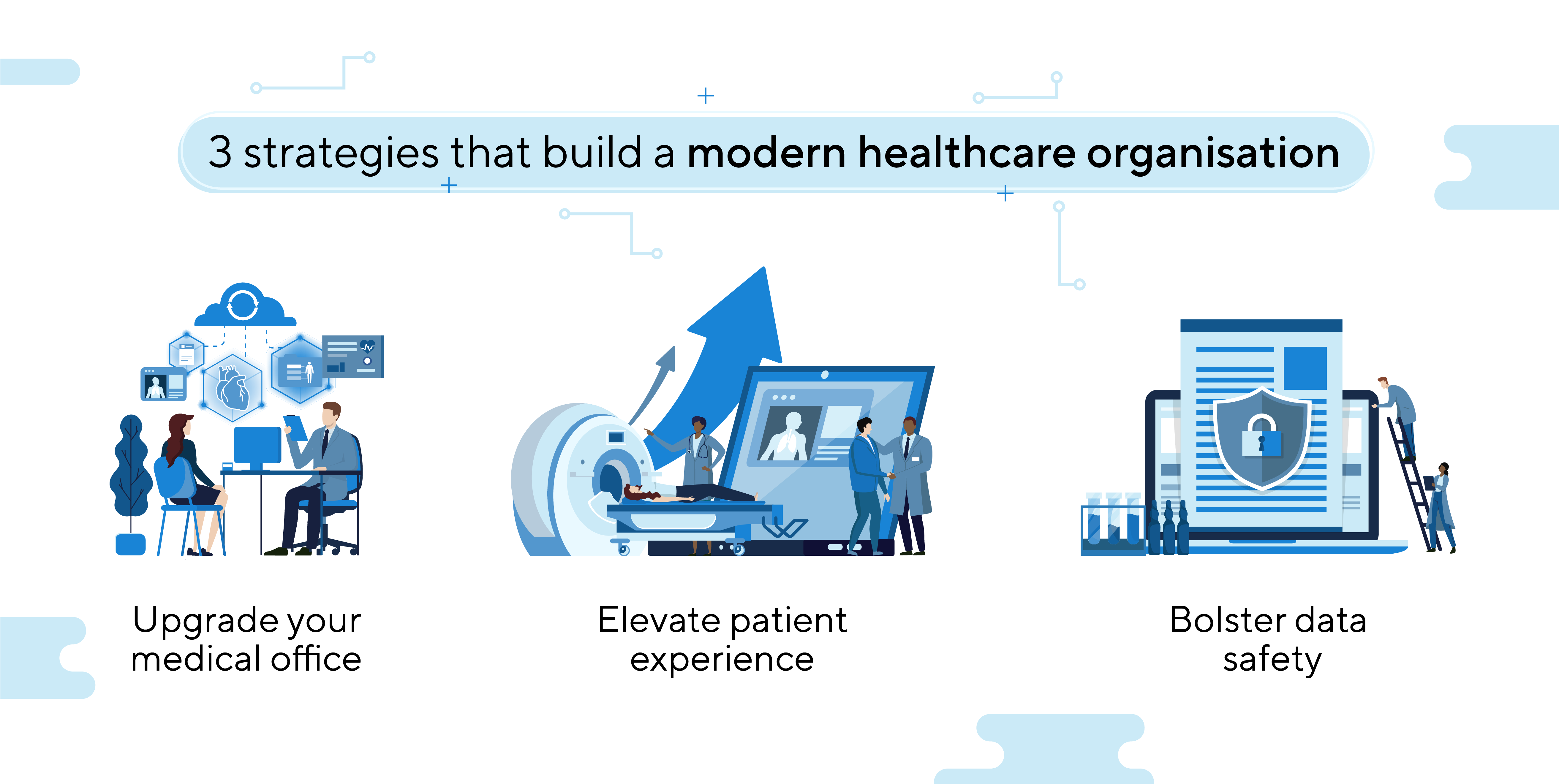Three healthcare digitalization strategies that put patients first

The healthcare sector is facing challenges like never before. An aging population, longer lifespans, and higher rate of chronic diseases place unique burdens on the industry. At the same time, healthcare is facing a serious shortage of workers – expected to reach 18 million in shortfall by 20301 – opening a yawning gap between demand and supply for healthcare services.
If there is a silver lining to the Covid-19 pandemic, it’s the way that it has accelerated the uptake of digital health. During the pandemic, healthcare organizations embraced telehealth services, digital health tools and programs to alleviate overcrowding and the spread of the virus at in-person healthcare centers. In turn, patient expectations have been reshaped around where, when and how they desire to receive healthcare. ASUS Business is committed to working with healthcare providers to introduce the right tools that will help elevate the healthcare experience for patients, while improving the working experience for providers.
Covid-19 got the ball rolling – and it’s now up to healthcare leaders to keep the momentum going. Long-term digital health strategies must coalesce around patient-centric, effective healthcare, aided by technology that’s purpose-built for the industry’s unique requirements, helping professionals in the field to work smartly, effectively, and securely.

Upgrade your medical office for personalized, quality care
Work in healthcare is diverse and complex. To provide care to a single patient, healthcare professionals may have to coordinate across multiple care teams, access and synthesize patient records, interface with various labs, and interpret medical reports and images. With labor shortages in many healthcare settings, delivering efficient and effective care is becoming more and more of a challenge.
This is at a time when CEOs are prioritizing patient experience – which 80% of CEOs say will become a top priority in the next 5 year2. According to McKinsey, putting patients at the heart of healthcare increases patient satisfaction, helping them feel more empowered and feel like they are receiving better care, “which helps lead to better health outcomes overall”3. To do so, care professionals need to be able to build 360-degree patient views, communicate easily across multiple care teams, and access the data needed to make informed decisions on the fly.

One place that leaders can start is with the medical office. Are doctors, nurses, clinicians, and other professionals equipped with reliable and purpose-built devices? Hospital mobility solutions like the ASUS portable ultrasound series allow doctors and nurses to deliver smart healthcare whether in the hospital, community facility, or home, integrating seamlessly with mobile app or web platforms for seamless data handling. In the hospital, intelligent telemedicine carts similarly enhance healthcare professionals’ workflow with powerful medical computer, reliable network-communication and long battery life.
Healthcare professionals today may work in a variety of settings, but wherever they are, they need patient data at their fingertips to provide timely and personalized care. Cloud-based, powerful, yet lightweight devices like ASUS Chromebook Enterprise laptops ensure that healthcare professionals have the applications and data to deliver quality care whether in the office, at the bedside, or from home.
Elevate patient experience with advanced analytics
70% of healthcare CEOs expect hospitals to evolve into ‘healthcare hubs’, with primary care distributed to ‘spokes’ in the community or even at home4. In time, we will see such home and community-based care come to rely more and more on connected devices.
This trend is converging with the rise in artificial intelligence and machine learning in healthcare settings. According to a December 2021 survey by Optum, most healthcare executives have adopted or plan to adopt AI strategies. In combination with Internet-of-Things and connected technologies, they plan to use AI to help with virtual patient care (41%), diagnosis and predicting outcomes (41%), and medical images interpretation (36%)5.
Already, ASUS edge and AI innovations like ASUS Blade and Miraico are improving hospital efficiency and workflows. Consumer healthcare apps devised by ASUS is also directly providing advanced healthcare services to patients, including online appointments with AI recommendations.
Bolster data safety to protect patients
The digitalization of healthcare puts all medical institutions and patients at risk. The increased dependence on Internet of Things means more endpoints for attack, and the greater amount of data collected means patients are exposed to greater risk. WeForum has sounded the alarm – saying that if healthcare doesn’t strengthen its cybersecurity, then it could soon be in ‘critical condition’6.
As healthcare leaders push their organizations to digitalize, they must have security in mind from the start. The number of healthcare breaches in the first five months of 2022 nearly doubled from the same period in 2021 – indicating growing sophistication among malicious actors. Companies need to evolve their defenses and rapidly invest in cybersecurity infrastructure, find and patch vulnerabilities, and update aging systems. At the same time, devices and digital tools must be secure by design. ASUS servers and workstations have built-in enterprise-grade security, suitable for critical healthcare data infrastructure.
With Covid-19 easing into the background, the opportunity is ripe for healthcare leaders to build the future of the profession. By focusing on these three pillars – devices, IoT and AI, security – healthcare professionals will be empowered to deliver effective care and services that put patients first.
- WeForum, CEOs explain how to respond to the biggest challenges in healthcare
- KPMG, 2021 Healthcare CEO Future Pulse
- McKinsey, The next frontier of care delivery in healthcare
- KPMG, 2021 Healthcare CEO Future Pulse
- Fierce Healthcare, Healthcare executives trust AI to automate administrative processes
- WeForum, If healthcare doesn’t strengthen cybersecurity, it could soon be in critical condition

